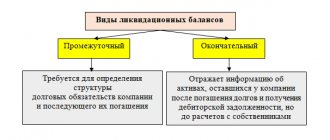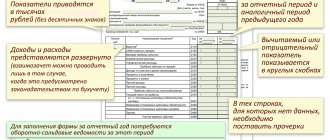The rules for disclosing information about related parties in financial statements, effective from January 1, 2008, are clarified. A comparative analysis of the relevant standards contained in PBU 11/2000, PBU 11/08 and IFRS 24 is provided.
Among the priority areas for improving corporate governance by the Government of the Russian Federation is the improvement of the legal regulation of affiliated entities, as well as the development of a system for recording and disclosing information about affiliated entities and beneficial owners (see the Program for the socio-economic development of the Russian Federation for the medium term (2006 - 2008) , approved by the Government of the Russian Federation dated January 19, 2006 N 38-r).
TRUST MANAGEMENT OF PROPERTY: FEATURES OF TAXATION
Starting from the annual financial statements for 2008, a new Accounting Regulation “Information on Related Parties” PBU 11/08, approved by Order of the Ministry of Finance of Russia dated April 29, 2008 N 48n, is in effect. Accordingly, the previously applied PBU 11/2000 “Information about affiliated persons” loses its force. Let's consider the main legislative changes and the possible consequences of their application.
If previously requirements for detailed disclosure of information about transactions with affiliates existed only for joint-stock companies (clause 1 of PBU 11/2000), then PBU 11/08 is mandatory for all commercial organizations (with the exception of credit institutions).
The task of maximum disclosure of information about transactions with affiliates was set by the Russian Ministry of Finance earlier. In particular, the Recommendations for conducting an audit of financial statements for 2004 - 2007 indicate that in the financial statements of organizations of other organizational and legal forms, it is advisable to disclose information about affiliated persons in relation to the procedure established by the previously effective PBU 11/2000 (see Letters from the Ministry of Finance of Russia dated 02/07/2005 N 07-03-01/93, dated 01/12/2006 N 07-05-06/2, dated 12/19/2006 N 07-05-06/302, dated 01/29/2008 N 07-05-06/ 18).
The obligation of joint stock companies to keep records of affiliated persons and submit reports on them in accordance with the requirements of Russian legislation is enshrined in clause 4 of Art. 93 of the Federal Law of December 26, 1995 N 208-FZ “On Joint Stock Companies” (as amended on April 29, 2008). The following cases of mandatory disclosure of information about affiliated persons for joint stock companies are provided for. Firstly, the securities prospectus must contain information about receivables and payables of affiliated persons (clause 1, 8, article 22 of the Federal Law of April 22, 1996 N 39-FZ “On the Securities Market”; Appendix No. 8 of the Regulations on disclosure of information by issuers of issue-grade securities, approved by Order of the Federal Financial Markets Service of Russia dated October 10, 2006 N 06-117/pz-n). Secondly, on a quarterly basis, joint stock companies are required to disclose information about affiliated entities in the form of a list of affiliated entities, as well as information about changes in their composition, which are submitted to the registration authority and published on the Internet page (clauses 8.5.1, 8.5 .3, 8.5.4 Regulations on disclosure of information by issuers of issue-grade securities). For limited liability companies, only the requirement to store lists of affiliated persons of the company is legislatively established (Clause 1, Article 50 of the Federal Law of 02/08/1998 N 14-FZ “On Limited Liability Companies” (as amended on 04/29/2008)).
ACCRUAL AND PAYMENT OF DIVIDENDS FROM PROFIT OF PAST YEARS
Previously, only clause 27 of PBU 4/99 “Accounting statements of an organization” obligated all organizations to disclose information about affiliated persons, without specifying what information was subject to disclosure in the explanations to the balance sheet and profit and loss statement. In practice, this, as a rule, came down to a simple list of affiliates placed in the explanatory note to the annual financial statements.
For small businesses, as before, a voluntary procedure for applying the provisions of PBU 11/08 is provided.
Let us recall that from January 1, 2008, paragraph 1 of Art. 4 of the Federal Law of July 24, 2007 N 209-FZ “On the development of small and medium-sized businesses in the Russian Federation” (as amended on October 18, 2007) introduced the following criteria for recognition as a small business entity.
1. For legal entities - the total share of participation of the Russian Federation, constituent entities of the Russian Federation, municipalities, foreign legal entities, foreign citizens, public and religious organizations (associations), charitable and other funds in the authorized (share) capital (share fund) of these legal entities persons should not exceed 25% (with the exception of assets of joint-stock investment funds and closed-end mutual investment funds), the share of participation owned by one or more legal entities that are not small and medium-sized businesses should not exceed 25%.
2. The average number of employees for the previous calendar year should not exceed 100 people.
3. Revenue from the sale of goods (work, services) excluding VAT or the book value of assets (residual value of fixed assets and intangible assets) for the previous calendar year should not exceed the limit values established by the Government of the Russian Federation.
Based on the literal interpretation of legislative norms, the voluntary procedure for disclosing information about related parties, provided for by the new PBU, does not apply to medium-sized businesses specified in Law N 209-FZ. In addition, not all subjects and small businesses will now be able to take advantage of the right, and not the obligation, to apply PBU 11/08. Thus, the voluntary procedure for applying the new PBU does not apply to cases where a small business entity publishes its financial statements in whole or in part in accordance with the legislation of the Russian Federation (constituent documents) or on its own initiative.
Expanding the range of entities required to disclose information about transactions with affiliated parties in their financial statements will allow the tax authorities to strengthen control over transactions with related parties and, accordingly, will increase the opportunities for applying the provisions of Art. 40 Tax Code of the Russian Federation.
Note that according to paragraphs. 5 p. 1 art. 23 of the Tax Code of the Russian Federation, organizations are required to submit financial statements at their location in accordance with the requirements of Federal Law dated November 21, 1996 N 129-FZ “On Accounting” (as amended on November 3, 2006), except for cases when organizations in accordance with This Law is not required to keep accounting records or is exempt from accounting.
Basic Concepts
In accordance with clause 4 of PBU 11/08, related parties - legal entities and (or) individuals - are able to influence the activities of the organization preparing financial statements, or the organization preparing financial statements is able to influence their activities. This paragraph also contains a list of persons who may be considered associated. First of all, these are affiliated entities recognized as such in accordance with the legislation of the Russian Federation.
Let us note that the previous PBU contained a reference norm on the issue of recognizing a person as affiliated, namely the provisions of the current Law of the Russian Federation dated March 22, 1991 N 948-1 “On competition and restriction of monopolistic activities in commodity markets” (as amended on July 26, 2006 ).
Example of analysis of a group of dubious organizations
Often, instead of the classic liquidation procedure, companies resort to an “alternative” one in the form of changing the director and founders or reorganization in the form of joining a shell company. To search for such facts, it is convenient to analyze the mass parameters of the group.
In the example below, in the group of potentially related organizations there are many that are in the process of reorganization, liquidation, or have already been liquidated. With a fairly large gross revenue (344 million rubles), the profit amounted to only 463 thousand rubles. (0.13% of revenue) - it is unlikely that real enterprises will operate with such low profitability.
Also in the group there are many cases of enforcement proceedings, facts of change of region, a large number of bankruptcies and many companies from the group were not found by legal address (no connection with the address), this individual is the founder or director of hundreds of companies:
A group of related organizations registered in the name of an individual
According to clause 4 of Law No. 948-1, affiliated persons of the organization are:
- members of its board of directors (supervisory board) or other collegial management body, members of its collegial executive body, as well as persons exercising the powers of its sole executive body;
- persons belonging to the group of persons to which the organization belongs;
- persons who have the right to dispose of more than 20% of the total number of votes attributable to voting shares;
- an organization in which this legal entity has the right to dispose of more than 20% of the total number of votes attributable to voting shares;
- If an organization is a member of a financial-industrial group, then its affiliates also include members of boards of directors (supervisory boards) or other collegial management bodies, collegial executive bodies of participants in a financial-industrial group, as well as persons exercising the powers of sole executive bodies of participants in a financial-industrial group. industrial group.
Accordingly, affiliates of an individual entrepreneur are:
- persons belonging to the same group as the given entrepreneur;
- an organization in which a given individual has the right to control more than 20% of the total number of votes attributable to voting shares.
When determining a group of persons, it is necessary to be guided by the list given in Art. 9 of the Federal Law of July 26, 2006 N 135-FZ “On the Protection of Competition” (as amended on April 29, 2008), since the relevant provisions of Art. 4 of Law N 948-1 have lost force.
The circle of persons capable of influencing the activities of the organization preparing financial statements has been expanded in the new PBU, which corresponds to the content of the similar IFRS 24 “Disclosure of information about related parties” and explains the change in the name of the PBU itself.
Example of analysis of a group of competitor companies
Another example: let’s filter all organizations by full name and get a cross-section of all companies in which the person we are interested in is the manager or founder. To do this, you must enter your full name in the search bar for connections. The size of a particular individual’s business can be roughly estimated by the parameters of total revenue and profit:
Example of analysis of a group of companies by manager
Situations of mandatory disclosure of information about related parties in financial statements
Paragraph 7 of PBU 11/08 introduced the definition of “control over a legal entity” as the ability to control decisions made by another legal entity in order to obtain economic benefits from the latter’s activities.
A comparison of previous and new rules regarding cases of control of another legal entity is presented below.
| Clause 7 PBU 11/08 | Clause 7 PBU 11/2000 |
| A legal and (or) individual, as a rule, controls another legal entity when such legal and (or) individual has: 1) by virtue of his participation in a business company (partnership) or in accordance with the powers received from other persons, more than 50% of the total number of votes attributable to voting shares (shares) in the authorized (share) capital of this business company (partnership) 2) the right to dispose (directly or through its subsidiaries) of more than 20% of the total number of votes attributable to voting shares (shares) in the authorized (share) capital of this business company (partnership), or contributions or shares constituting the authorized (share) capital given legal entity and has the ability to determine decisions made by such legal entity | An organization or individual controls another organization when such organization or individual has the right: 1) dispose (directly or through its subsidiaries) of more than 50% of the voting shares of a joint stock company or more than 50% of the authorized (share) capital of a limited liability company 2) dispose (directly or through its subsidiaries) of more than 20% of the voting shares of a joint stock company or more than 20% of the authorized (share) capital of a limited liability company and has the ability to determine decisions made in these companies |
The significance of the changes made becomes obvious when referring to the norms of corporate law. So, paragraph 1 of Art. 32 of Law No. 14-FZ determines that each company participant has at the general meeting of company participants a number of votes proportional to his share in the authorized capital of the company, except for cases provided for by this Law. The charter of the company upon its establishment or by introducing amendments to the charter of the company by decision of the general meeting of the company's participants, adopted unanimously by all the company's participants, may establish a different procedure for determining the number of votes of the company's participants.
In joint stock companies, voting at a general meeting of shareholders is carried out according to the principle of “one voting share of the company - one vote,” with the exception of cumulative voting. However, the company’s charter may establish restrictions on the number of shares owned by one shareholder and their total par value, as well as the maximum number of votes granted to one shareholder (Clause 3, Article 11, Article 59 of Law No. 208-FZ).
Thus, the percentage of voting shares and shares in the authorized capital in practice may not always correspond to the percentage of the total number of votes.
Please note that the updated provisions of clause 7 of PBU 11/08 comply with the criteria for recognizing persons as affiliates given in Art. 4 of Law N 948-1. The concept of “significant influence” remains the same and is defined as the ability to participate in the decisions of another legal entity, but not as control. Clause 8 of PBU 11/08 provides examples of such influence. In particular, significant influence may occur due to participation in the authorized (share) capital, provisions of the constituent documents, concluded agreement, participation in the supervisory board and other circumstances.
ACCOUNTING
Interdependent persons in the Tax Code of the Russian Federation
In tax legislation, the concept of “related party” is used. It is revealed in Art. 105.1 Tax Code of the Russian Federation. Thus, on the basis of paragraph 1 of this article, if the peculiarities of relations between persons may influence the conditions and (or) results of transactions made by these persons, and (or) the economic results of the activities of these persons or the activities of the persons they represent, these persons are recognized as interdependent for tax purposes.
In paragraph 2 of Art. 105.1 of the Tax Code of the Russian Federation lists the grounds according to which taxpayers are recognized as interdependent. So, for tax purposes, related parties are:
- organization, if one organization directly and (or) indirectly participates in another organization and the share of such participation is more than 25%;
- an individual and an organization if such an individual directly and (or) indirectly participates in such an organization and the share of such participation is more than 25%;
- organizations, if the same person directly and (or) indirectly participates in these organizations and the share of such participation in each organization is more than 25%;
- organization and person (including an individual together with his spouse, parents (including adoptive parents), children (including adopted children), full and half brothers and sisters, guardians (trustees) and wards) having powers by appointment (election) of the sole executive body of this organization or by appointment (election) of at least 50% of the composition of the collegial executive body or board of directors (supervisory board) of this organization;
- organizations whose sole executive bodies or at least 50% of the composition of the collegial executive body or board of directors (supervisory board) of which are appointed or elected by decision of the same person (an individual together with his spouse), parents (including adoptive parents ), children (including adopted children), full and half brothers and sisters, guardians (trustees) and wards);
- organizations in which more than 50% of the composition of the collegial executive body or board of directors (supervisory board) consists of the same individuals together with their spouse, parents (including adoptive parents), children (including adopted children), full-born and half-brothers and sisters, guardians (trustees) and wards;
- organization and person exercising the powers of its sole executive body;
- organizations in which the powers of the sole executive body are exercised by the same person;
- organizations and (or) individuals if the share of direct participation of each previous person in each subsequent organization is more than 50%;
- individuals in the event that one individual is subordinate to another individual due to official position;
- an individual, his spouse, parents (including adoptive parents), children (including adopted children), full and half brothers and sisters, guardian (trustee) and ward.
Disclosure requirements for related party transactions
The definition of “transactions between an organization preparing financial statements and a related party” has been added. In particular, clause 5 of PBU 11/08 establishes that such an operation is considered to be any operation for the transfer (receipt) of assets, the provision (consumption) of services or the emergence (termination) of obligations (regardless of the receipt of payment or other consideration) between the organization that constitutes financial statements, and related parties. The approximate list of transactions with related parties has been slightly adjusted (clause 5 of PBU 11/08). As before, examples of related party transactions correlate with a similar list presented in IFRS 24 (Table 1).
Table 1 Examples of transactions with related parties in Russian and international accounting standards
| Clause 5 PBU 11/08 | Paragraph 20 of IAS 24 | Clause 5 PBU 11/2000 |
| Purchase and sale of goods, works, services | Purchases or sales of goods (finished or unfinished goods) | Disclosure requirement similar to that contained in the new PBU |
| Providing or receiving services | ||
| Acquisition and sale of fixed assets and other assets | Purchases or sales of property and other assets | |
| Renting property and providing property for rent | Rent | |
| Financial transactions, including loans | Transfer under financial agreements (including loans and contributions to the authorized capital in cash or in kind) | Financial transactions, including the provision of loans and participation in the authorized (share) capital of other organizations |
| Transfer in the form of a contribution to authorized (share) capital | ||
| Providing and receiving security for the fulfillment of obligations | Providing guarantees or security | Providing and receiving guarantees and pledges |
| Transfer of research and development | Transfer of research and development results | |
| Transfer under license agreements |
As before, the nature of the relationship between related parties is subject to description in the financial statements, regardless of whether transactions between them took place during the reporting period (clause 13 of PBU 11/08). This requirement is consistent with paragraph 13 of IFRS 24, according to which, in order for users of financial statements to form an opinion about the effect of related party relationships on the entity, information about the related party relationships should be disclosed in cases where control exists, regardless of whether transactions between these related parties.
Organizations that conducted transactions with related parties should take into account that the list of information disclosed in the financial statements has been expanded and is as close as possible to the provisions of IFRS 24 (Table 2).
Table 2 Requirements for minimum disclosure of information about transactions with related parties in Russian and international accounting standards
| Clause 10 PBU 11/08 | Paragraph 17 of IAS 24 | Clause 12 PBU 11/2000 |
| Nature of the relationship (in accordance with clause 6 of PBU 11/08) | Disclosure requirement similar to that contained in the new PBU | |
| Types of operations | ||
| Volume of transactions of each type (in absolute or relative terms) | Amount of transactions performed | |
| Cost indicators for operations not completed at the end of the reporting period | Amount of outstanding settlement balances | |
| Similar disclosure requirements are specified in paragraph 5 | Details of any guarantees given or received | Similar disclosure requirements are specified in paragraph 5 |
| Methods used to determine prices for each type of transaction with an affiliate | ||
| Conditions and terms for carrying out (completion) of settlements for transactions, as well as the form of settlements | Conditions associated with outstanding settlements, including the security and nature of the consideration provided upon settlement | |
| The amount of reserves formed for doubtful debts at the end of the reporting period | Provisions for doubtful debts related to the amount of outstanding balances | |
| The amount of written off receivables for which the statute of limitations has expired, other debts that are unrealistic for collection, including through the reserve for doubtful debts | Expense recognized during the period in respect of bad or doubtful debts due from related parties |
Since 2008, the requirement for mandatory disclosure of information on the methods used to determine prices for each type of transaction with an affiliate has been removed.
Paragraph 12 of PBU 11/08 introduced requirements similar to IFRS 24 for mandatory disclosure of information on the amount of remuneration paid to key management personnel in the aggregate and for each of the following types of payments.
1. Short-term remuneration - amounts payable during the reporting period and 12 months after the reporting date (wages for the reporting period, taxes accrued on it and other obligatory payments to the relevant budgets and extra-budgetary funds, annual paid leave for work in the reporting period, payment by the organization for treatment, medical care, utilities, etc. payments in favor of key management personnel).
Related persons in accounting
According to clause 4 of PBU 11/2008, related persons (parties) are recognized as:
- affiliates;
- persons carrying out joint activities, if one of them prepares financial statements;
- legal the person preparing the financial statements and the non-state pension fund acting in the interests of the employees of such legal entity. person or other person recognized as a related party to the legal entity. person preparing financial statements.
Typically, a person has the ability to influence the decisions of another person under the following conditions:
- due to the presence of over 50 percent of voting shares (shares) in the authorized (share) capital;
- if you have the right to more than 20 percent of voting shares (stakes) and the ability to determine decisions made by the organization.
As follows from paragraph 13 of PBU 11/2008, if the nature of relations in a group of related persons is reflected in the financial statements, regardless of the presence or absence of business transactions for a specific period, such information is reflected in a separate paragraph in the explanatory note.






